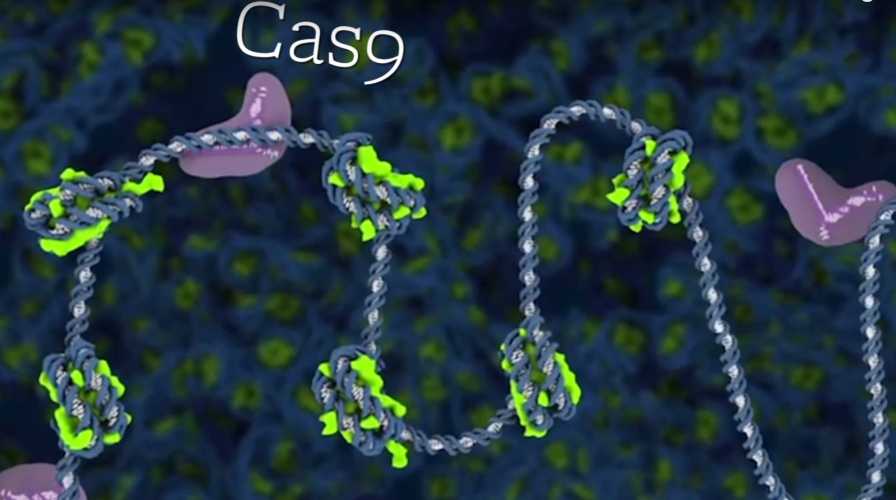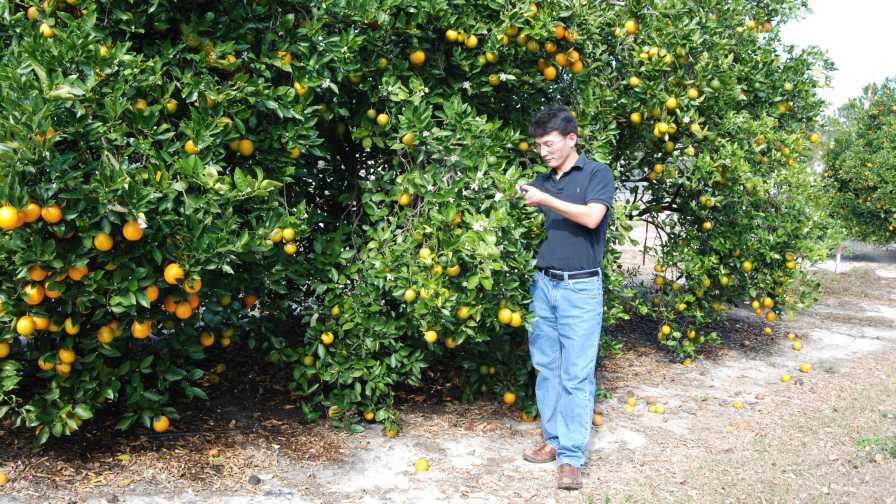Can CRISPR Carry Agriculture Innovation To The Next Level?

Cas9 seeks out certain sections of DNA chains to “clip out” undesirable traits, and in some cases, add in new desirable attributes.
Illustration courtesy of UC Berkeley
For years, the discussion surrounding genetics in agriculture focused on the use of GMOs and transgenics. With it came controversy about the safety and processes used to genetically modify crops. Despite scientific consensus that GMOs are safe, the debate continues.
But, as is often the case, science marches forward and a new genetics breakthrough called CRISPR/Cas9 promises to supersede GMOs. The technology is making headlines already and will surely make more in the future.
The technique, which was discovered in 2012 by Jennifer Doudna, a Biochemist with UC Berkeley, and Emmanuelle Charpentier, a Microbiologist now at the Max Planck Institute for Infection Biology, is highly technical to describe. In layman’s terms, it allows DNA to be edited, turning off undesirable outcomes at the gene level. Desirable traits also can be added at the cellular level.
CRISPR is short for “clustered regularly interspaced short palindromic repeats.” The technology is derived from the age-old battle between viruses and bacteria. Viruses attack bacteria and take them over. Sometimes bacteria survive an attack, and when they do, they save a copy of the DNA from the virus. The viral DNA is saved in the part of the bacteria called CRISPR. When the virus attacks the bacteria again, the bacteria arms the Cas9 protein with the bit of viral DNA. The Cas9 protein then moves throughout the cell looking for the attacking viral DNA. When it finds the matching viral DNA, the Cas9 essentially cuts the viral DNA, rendering it ineffective.
“One of the major advantages of CRISPR/Cas9 technology is that a gene can be knocked out,” says Dr. Wayne Hunter, a Research Entomologist at USDA’s Horticultural Research Laboratory in Ft. Pierce. “So, if a gene would normally produce a toxin or allergic protein, the plant would no longer be able to produce that protein. Plus, since no additional genetic material would be added — the plant would not be transgenic.”
And the process can be implemented quickly. In a New York Times article, geneticist Bruce Conklin said of the technology: “In the past, it was a student’s entire PhD thesis to change one gene. CRISPR just knocked that out of the park.”
Not only is the technique much faster than conventional breeding, it also is very versatile. The approach has worked in just about every cell type tested thus far — plant and animal.
And to grasp the rate at which researchers are studying CRISPR/Cas9, there were hardly any scientific publications on the technology in 2012. In 2014, there were more than 225 published.
To say CRISPR/Cas9 is every bit as revolutionary as the Internet or the smartphone is an understatement. Scientists are studying applications to fight cancers and it already has been demonstrated the technology can remove HIV from infected human cells. It comes with ethical questions as well for how this technology may benefit humans in the future. The idea of designer babies with reduced diseases linked to faulty genes, or the potential to slow or reverse the aging process may one day be possible using CRISPR/Cas9. Many more human health, animal, and plant applications are being investigated.

Dr. Nian Wang is researching methods to defeat HLB using CRISPR.
Photo courtesy of UF/IFAS
Applications To Agriculture
Hunter adds the potential applications to CRISPR/Cas9 technology to agricultural problems are endless.
“CRISPR/Cas9 permits highly selective editing at the gene level,” he says. “With the technology, comes the need for researchers to understand the biological pathways, their components (genes), and gene functions.”
With this understanding, scientist can target things like vulnerability to diseases, or even take the bitterness out of a piece of fruit.
“Working in cell cultures, new varieties of plants can be produced, which have reduced or no toxins, or no bitter proteins since they can be knocked out,” Hunter says. “Since the technology works at the embryonic stage, all subsequent plants propagated from the new variety also will continue to have the selected trait (not bitter), being permanent like what occurs in natural gene mutations through traditional breeding.”
Dr. Nian Wang, an Associate Professor of microbiology at the UF/IFAS Citrus Research and Education Center in Lake Alfred, is using CRISPR/Cas9 to attempt to create non-transgenic citrus varieties that are resistant or tolerant to HLB.
Wang began using CRISPR/Cas9 in 2013 to develop canker-resistant varieties and started HLB research in 2015.
“We are the first to adapt the technology to citrus,” he says. “We have identified critical genes involved in HLB-symptom development. We will mutate the genes involved in symptom development to stop its development.”
 He adds the CRISPR/Cas9 approach has advanced very quickly since its discovery in 2012. And, the fact new trees developed with the technology are not GMOs will speed the approval process.
He adds the CRISPR/Cas9 approach has advanced very quickly since its discovery in 2012. And, the fact new trees developed with the technology are not GMOs will speed the approval process.
“The non-transgenic citrus can be commercialized within a very short time (perhaps less than two to three years),” Wang says. “Since the trees contain no foreign DNA, the deregulation is pretty simple.”
At USDA, Hunter is working on an “ingestible CRISPR/Cas9 system” aimed at knocking out a gene in the psyllid so it will not be able to acquire or transmit HLB. This would be a non-transgenic approach that would eliminate a native gene in the psyllid’s digestive system. The product could be applied each spring over several generations of psyllids so the pest would no longer be able to transmit the HLB bacteria.
“Another approach is to knock out a bacterial immune gene in the psyllid, so when psyllids are infected with bacteria (more than 10 species of bacteria are known to inhabit psyllids), the bacterial infection — even HLB bacteria — would overwhelm the psyllid’s immune system and cause it to die,” Hunter says.
In addition to Hunter and Wang, there are a number of scientists working on CRISPR/Cas9 technology and its delivery to target either the psyllid or HLB bacteria. CRISPR/Cas9 technology has been called a game changer, and citrus growers hope it proves to be so in the fight against HLB.
Genetically Modified Crops Vs. CRISPR/Cas9
Compared with conventional genetic engineering, the CRISPR/Cas9 system has several unique features in crop improvement:
- Genetic changes are made in specific genes at native locations of the genome.
- Crop plants improved by CRISPR/Cas9 can be free of foreign DNA, making them comparable with those developed by conventionally mutation breeding methods, such as chemical treatment or physical irradiation, in terms of genetics.
- If foreign genes must be introduced, they will be integrated into genomic locations that are carefully chosen and are known to have minimal or no negative on other genes.
- Targeting multiple genes in a single experiment has been proven to be doable in several species, allowing manipulating traits involving multiple genes.
Source: Kenong Xu, Cornell University
Boundless Potential
CRISPR/Cas9 research is proliferating into other crops as well. There is a potato that will last longer in cold storage and produces less of a suspected carcinogen when it is fried. There is a mushroom that has been edited to reduce browning. Of note for both of these CRISPR/Cas9 creations, USDA has opted not regulate them as they do traditional GMO crops. The agency has indicated that it views the CRISPR/Cas9 approach more in line with traditional plant breeding practices because no foreign DNA or proteins are introduced and thus in no need of regulation.
And, the technology’s ability to suppress or enhance traits seem limitless. Plants can be edited for disease, insect, and drought resistance. Improved photosynthesis can be engineered in plants. Livestock can be enhanced using the technology. In fact, it is being tested now to fight African swine fever, which is a devastating disease impacting small farms in Africa.
While CRISPR/Cas9 is a complex process to visualize, in the world of science, it is remarkably elegant, simple, repeatable, and fast, opening a world of possibilities for the future of agriculture and the challenge of feeding 9 billion people by 2050. It is a powerful tool that must be treated ethically and with respect.










